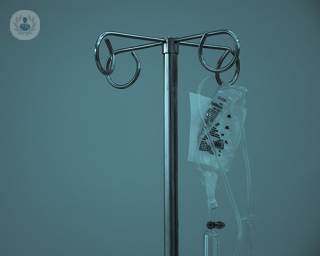Electrochemotherapy
Mr Alastair MacKenzie Ross - Plastic surgery
Created on: 01-22-2018
Updated on: 06-08-2023
Edited by: Karolyn Judge
Electrochemotherapy is a treatment for skin cancer. The treatment involves chemotherapy drugs being injected directly into the cancer cells into the tumour or bloodstream. Following this, a special probe is introduced to the skin to send an electric pulse direct to the tumour, which changes the composition of the cancer cell, allowing the chemotherapy to enter the cell more easily, this part of the process is called electroporation.

What types of cancer is electrochemotherapy used to treat?
Electrochemotherapy is used for cancers that either start in the skin, or that spread to the skin from another location.
These include:
- basal cell carcinoma
- squamous cell carcinoma
- breast cancer that has spread to the skin
- head and neck cancers that have spread to the skin
- Karposi sarcoma – a type of cancer caused by a virus
- angiosarcoma - a cancer of the inner lining of blood vessels
- melanoma
What is the process for electrochemotherapy?
A patient undergoing electrochemotherapy, will first have an injection of chemotherapy (usually either cisplatin or bleomycin). The injection will either be directly into the tumour, or into the bloodstream. Following this, a probe is applied to the area of skin cancer, i.e. the tumour and electrical pulses are passed through the tumour. The probe may either be two electrodes that press against the skin, or they may be a series of fine pins that will be pushed into the skin.
The electrochemotherapy process usually takes around 10 to 60 minutes depending on the type of tumour.
What are the benefits of electrochemotherapy?
The benefits of electrochemotherapy over other treatments for skin cancer are that the levels of chemotherapy needed are much less than with traditional chemotherapy, meaning that the side-effects are greatly reduced.
The scarring is less than with treatments where the skin cancer is cut away.
There can be some pain at the source of the treatment due to the electrical pulses, and to the pins going into the tumour.
Electrochemotherapy is a relatively new treatment, meaning the benefits and effectiveness are still being studied and understood.
Is electrochemotherapy painful?
There are side effects of electrochemotherapy, which include:
- Pain in the area where the electrode touches the skin
- Muscle contractions
- Mild nausea
- Infection - the chances of this is rare, but you should speak to a doctor if you notice the area that's been treated becoming red, swollen, painful or if there's discharge
- Skin colour changes - this usually fades over time but can be permanent for some patients
- Ulcer or skin breakdown in the treated area - it can take up to two weeks to heal after dressing it
Which specialist undertakes electrochemotherapy treatment?
Surgical oncologists and dermatological plastic surgeons are specialists that can treat skin cancer using electrotherapy treatment.





